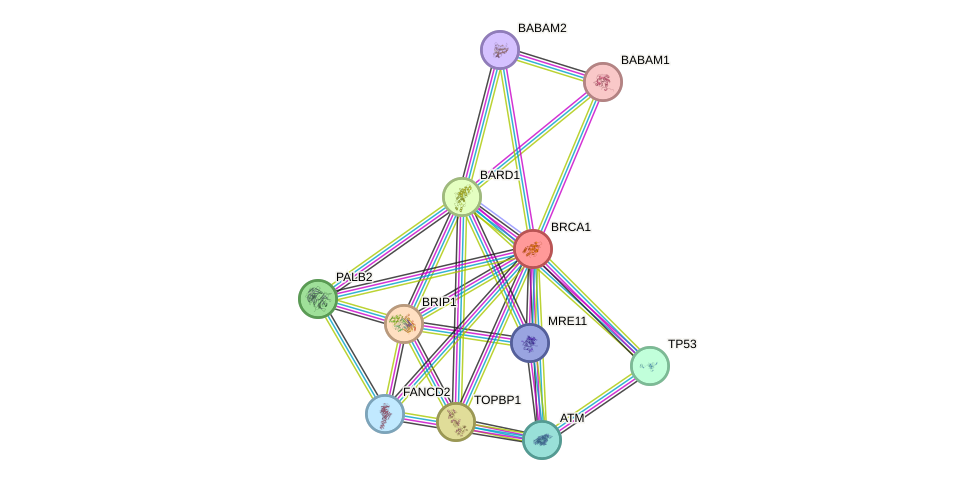GenAge entry for BRCA1 (Homo sapiens)
Entry selected based on evidence directly linking the gene product to ageing in a mammalian model organism
Gene name (HAGRID: 61)
- HGNC symbol
- BRCA1
- Aliases
- RNF53; BRCC1; PPP1R53; FANCS
- Common name
- breast cancer 1, early onset
Potential relevance to the human ageing process
- Main reason for selection
- Entry selected based on evidence directly linking the gene product to ageing in a mammalian model organism
- Description
BRCA1 is crucial in cellular responses to DNA damage and may also be a transcriptional regulator. It interacts with WRN [1825]. Mutations in BRCA1 result in embryonic lethality in mice and humans. Mice hypomorphic for BRCA1 and heterozygous for TP53 have slower growth rates and display signs of premature ageing starting at about 8 months of age [37]. Loss or haploid loss of CHEK2 also enables mice lacking BRCA1 to avoid embryonic lethality and display signs of premature ageing at about 18 months of age and develop multiple tumours later in life [1838]. In humans, some evidence suggests differences in BRCA1 genotype frequencies between centenarians and controls [416]. BRCA1's role in cancer in humans is undisputed [396], and it is possible it also plays a role in ageing.
Cytogenetic information
- Cytogenetic band
- 17q21
- Location
- 43,044,295 bp to 43,125,483 bp
- Orientation
- Minus strand
Protein information
- Gene Ontology
-
Process: GO:0000724; double-strand break repair via homologous recombination
GO:0000729; DNA double-strand break processing
GO:0000731; DNA synthesis involved in DNA repair
GO:0000732; strand displacement
GO:0006260; DNA replication
GO:0006301; postreplication repair
GO:0006302; double-strand break repair
GO:0006303; double-strand break repair via nonhomologous end joining
GO:0006349; regulation of gene expression by genetic imprinting
GO:0006351; transcription, DNA-templated
GO:0006357; regulation of transcription from RNA polymerase II promoter
And 49 more GO terms Cellular component: GO:0000151; ubiquitin ligase complex
GO:0000800; lateral element
GO:0005634; nucleus
GO:0005654; nucleoplasm
GO:0005694; chromosome
GO:0005737; cytoplasm
GO:0005886; plasma membrane
GO:0008274; gamma-tubulin ring complex
GO:0030529; intracellular ribonucleoprotein complex
GO:0031436; BRCA1-BARD1 complex
GO:0043234; protein complex
And 2 more GO terms
Show all GO termsFunction: GO:0003677; DNA binding
GO:0003684; damaged DNA binding
GO:0003713; transcription coactivator activity
GO:0003723; RNA binding
GO:0004842; ubiquitin-protein transferase activity
GO:0005515; protein binding
GO:0008270; zinc ion binding
GO:0015631; tubulin binding
GO:0019899; enzyme binding
GO:0031625; ubiquitin protein ligase binding
GO:0044212; transcription regulatory region DNA binding
And 2 more GO terms
Protein interactions and network
- Protein-protein interacting partners in GenAge
- TP53, ATM, STAT5A, AKT1, MYC, PEX5, PARP1, BRCA1, CREBBP, HIF1A, RPA1, BLM, BCL2, HSP90AA1, ABL1, BRCA2, TOP2A, RAD51, UBE2I, ERCC6, EP300, TERF1, PRKDC, AR, XRCC5, PCNA, TERF2, XRCC6, HSPA8, RB1, FOXO3, HDAC1, HSPD1, YWHAZ, SP1, JUN, MAPK3, CCNA2, PIK3R1, TFAP2A, CREB1, JAK2, CDK1, E2F1, HDAC2, RELA, VCP, JUND, NBN, SUMO1, H2AFX, CEBPB, ESR1, MTOR, CTNNB1, CDKN2A, PPP1CA, TP63, ATR, MLH1, CHEK2, TP53BP1, TP73, NFE2L2, CDK7, RICTOR
- STRING interaction network
Retrieve sequences for BRCA1
Homologs in model organisms
In other databases
- GenAge model organism genes
- A homolog of this gene for Mus musculus is present as Brca1
- LongevityMap
- This gene is present as BRCA1
- CellAge
- This gene is present as BRCA1
- CellAge gene expression
- This gene is present as BRCA1

